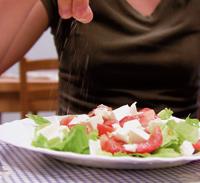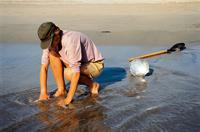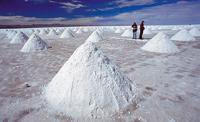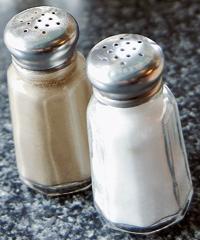1 teaspoon of iodized salt

Long ago, man began the struggle against the lack of iodine. Imagine. In 2800 the Chinese recommend taking marine algae of the genus sargassum to combat goiter. The Chinese did not know that inflammation of the throat area was a consequence of the lack of iodine; as they knew, iodine was not found and until 1811. And, however, they did not work by the bad way, in any way, with iodine in the sea to top, because the foods of marine origin (algae, seafood, fish...) also have a lot of iodine.
Today we know that the lack of iodine generates goiter and many other diseases. In fact, iodine is the basic element of hormones that produce thyroid glands, and when in the diet we do not take the necessary iodine, various health imbalances occur.
And yes, as the Chinese suggested at the time, the best way to take iodine properly and naturally is to eat marine foods. But it is only for those who can do it. In fact, the World Health Organization (WHO) estimates that about two billion people are affected by the lack of iodine, one-third of the world's population. And most of them, inevitably, cannot access foods of marine origin: either by poverty, by the remoteness of the sea or by eating habits.
Solution: add iodine to salt
Since the last century, various foods such as water, bread, milk, oil and salt have been enriched. And from these experiences, it has been well demonstrated that the promotion of iodated salt intake is the most effective way to end the global shortage of iodine.

The first iodate salt campaign was held in Ohio in 1917 and soon after, in 1922, was followed by Switzerland. However, the use of iodate salt did not extend much and the scant diffusion was made especially towards Western countries. The consumption of iodated salt has received a real boost since 1990. That year, the World Children's Summit was held, in which a diagnosis of the world's absence of iodine was made. The consumption of iodate salt also did not reach 20% of households in underdeveloped countries, and 110 countries around the world had the problem of iodine deficiency.
The absence of iodine in a country means it affects the public health of the country. Lack of iodine causes diseases in all ages, from children to adults. The goiter can be one of the most well-known diseases, the growth of the thyroid gland, but not for it the most serious.

The lack of iodine especially affects pregnant women and children in a situation of lactation. The lack of iodine in the pregnant woman increases the risk of abortion and the death of the baby. In addition, the baby can be born with certain anomalies: intellectual disability, deafness, strabismus, nanism... In children, the lack of iodine is especially dangerous until three months, when the child's brain develops rapidly.
Numerous studies have been carried out which have found that in populations with iodine deficit the child intellectual quotient is between 10 and 15 points below normal. They are apparently normal children, but school performance and some intellectual abilities are reduced. Lack of iodine is the leading cause of mental retardation in avoidable children.
The intellectual disability that affects children mainly motivated government authorities to make firm decisions at the 1990 World Children's Summit. A campaign was launched to add iodine to salt from all over the world.
They chose salt as a means of transportation of iodine. Salt, and not another food, since salt is consumed in almost everyone, which allows you to reach almost every corner. In addition, the addition of iodine to salt is a cheap and relatively easy to control process, since in most states the production of salt depends on few companies. In addition, iodated salt is a very stable mixture and similar to common salt, since iodine does not affect the color, flavor and smell of salt.
Results of the last years

The authorities present at the 1990 summit pledged to end the lack of iodine by the year 2000. And the year 2000 passed, but the shortage of iodine did not disappear. However, global consumption of iodated salt has increased considerably, from 20% in 1990 to 66% in 2003. This consumption of iodated salt has eliminated diseases caused by the lack of iodine in several countries: In 1990 there were 110 countries with iodine deficiency and in 2003, 54.
However, it cannot be forgotten that five of these 54 countries have consumed iodine in excess. This highlights the need to preserve the concentration of iodine in salt and ensure moderate consumption of iodate salt. Excessive consumption of iodine can also cause thyroid alterations and excessive consumption of salt can cause problems of hypertension.
Facing the future...
The lack of iodine remains a global problem. Analyzing children between six and twelve years old, Southeast Asia is in the worst situation, where 96 million children suffer from iodine deficiencies. It is followed by Africa and Western Pacific, with 50 million children each. In Europe and the east of the Mediterranean there are 40 million children affected by the lack of iodine and in America about 10 million.
Extrapolating the proportion of children to the entire population, around the world approximately 2,000 million people suffer from diseases caused by the lack of iodine. In addition, we must not forget that data from 66 countries are missing

In 2002, the United Nations set a new date to end the lack of iodine, in 2005. At the end of this year there is little left, and it seems that in this case it will also be complicated to achieve it. The iodated salt remains to be opened and, in addition to spreading it, it will be necessary to take measures to maintain this consumption in the future. In addition, people who can't or can't take iodine salt will have to offer other options, other iodine enriched foods. In any case, to maintain the path begun in 1990, international support and the real commitment to change the situation by countries with iodine deficit will be essential.
How many iodate salts a day?

The need for iodine varies depending on the age and physiological situation. Newborn babies need about 50 micrograms per day and from age the need for iodine increases to 150 micrograms per day for older than 12 years and adults. On the other hand, this need increases considerably in pregnancy (about 175 micrograms per day) and in lactating women (about 200 micrograms per day). The extraordinary need for these last two groups is perfectly understandable, since the mother must give the iodine to the baby or the newborn.
Thus, according to the World Health Organization, if adults take a teaspoon of salt a day, 5 grams of salt, we would have the iodine needed. Children need a little less, half a teaspoon of salt. Finally, pregnant and/or lactating women, in addition to iodated salt, say they should take supplements rich in iodine.





